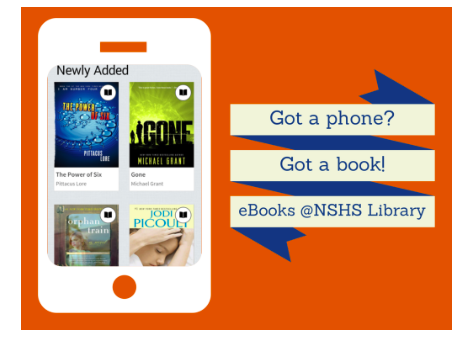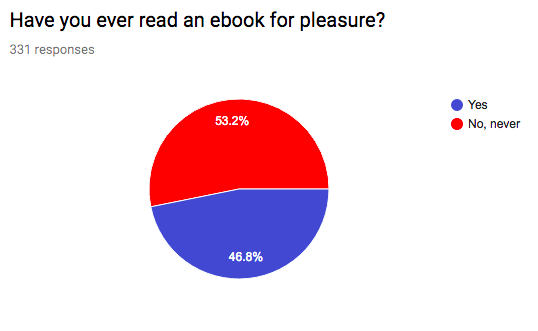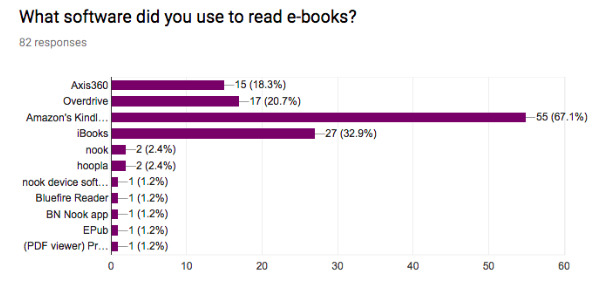and received a 2017 Web Seal of Excellence.
There were many steps on our journey. First up was simply to measure awareness. We had ebooks, but did students and faculty know it? For students who were using ebooks, what platforms were they using, what technology? We needed this data to decide how to move forward.
We also wanted to get data across the school, not just from who was in the library, or was checking the books out. We ended up using our sophomore speech project - which brings just about every sophomore in the building to the library for a class - to try to capture results from students who might not volunteer for an ebook survey. A quick Google Forms questionnaire, used as an in-class activator, allowed us to easily capture data from almost the entire grade. Repeating it multiple times over the study period let us track whether new services and outreach programs were having an impact.
 One of the promotions we displayed on school televisions
One of the promotions we displayed on school televisions
As this was going on we tried to increase promotion of our ebook platforms and tools. We created ads to run on our web site and displayed throughout the library. We also create promos that could run on television displays throughout the school. We also reached out to parents, sending information home in our newsletter, and putting a display out for back to school night. And we promoted the tools to the faculty as well, hosting lunch-time tutorials where teachers could bring their devices and get set up on our ebook platform.
View your options - what’s out there? At the beginning of our process, Overdrive was our main ebook platform. We paid for hosting services, as well as individual book purchases, and most of the books we purchased were intended for independent reading. We did have a few other books purchases from Follett that could be accessed through the Destiny catalog using Follett Shelf software, though most of these were multi-user books focused on curriculum support.
Fortunately, we began this process as the state began rolling at the Commonwealth ebook platform, which our district joined. We did run into some difficulties on our end getting the program working correctly, but once it was set up, it offered thousands of additional book choices to our readers.
This also meant we needed to begin another bout of promotional outreach, informing students, parents and faculty of the new tool and how to access it. And that also necessitated a new round of surveys. Were our users trying both of the options now available? Did they prefer one to the other for ease of use or variety of materials? Back to the sophomores! We had a new class that we could survey and track as they came in for their sophomore speech unit. We also tried a new method, setting up a Chromebook loaded with the survey at the check-in desk, and asking every student who came by to take the survey. We thought at first that we might have to offer incentives (lollipops? pencils?) but we were surprised that students were happy to fill it out, and seemed to enjoy having their opinions being solicited.
Analyzing our data revealed that while there was some interest in ebooks at our school, it was relatively small. This is actually not that surprising; according to a recent study by the Nielsen Company “while younger readers are open to e-books as a format, teens continue to express a preference for print that may seem to be at odds with their perceived digital know-how” (Nielsen).
So while we had demand for some books, was it worth the cost, particularly in this era of belt-tightening and budget cuts? When we did an analysis of the platforms we were using, it just didn’t pan out. In the end, we proposed eliminating our own hosted system (Overdrive) in favor of the state ebook platform. For specific books we wanted to purchase directly for our school, such as curriculum resources, books for our book club, or in demand titles not available through the state program, we’ll use Follett.
Our decision may not be the right one for your school. Going into this process we would not have predicted that we would recommend scaling back on our ebook purchasing, but that is where our data lead us. And it’s important to remember that this is not the end of our process. We will continue to evaluate our materials, be on the lookout for new options, and most importantly, listen to our users.
“Don't Judge a Book by Its Cover: Tech-Savvy Teens Remain Fans of Print Books.” What People Watch, Listen To and Buy, Nielsen Company, 9 Dec. 2014, www.nielsen.com/us/en/insights/news/2014/dont-judge-a-book-by-its-cover-tech-savvy-teens-remain-fans-of-print-books.html.



